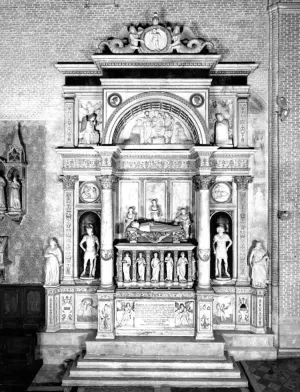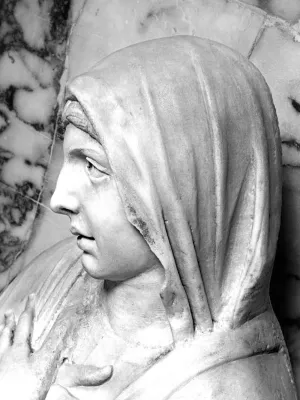Looking Closely
July 28, 2017
By Ellen Prokop, Digital Art History Lead

Scholars celebrate photo archives for providing access to little-known works of art housed in private collections or in circulation on the art market. Over the past 97 years, the Frick Art Reference Library has collected thousands of reproductions of paintings and sculptures that researchers rarely have the opportunity to study in person. A feature of photo archives that is less often appreciated, however, is how comprehensively they document famous works of art on public view. One example is the monumental wall tomb of Doge Andrea Vendramin (1392–1476), presently installed in the church of SS. Giovanni e Paolo in Venice, Italy (see illustration). Produced in the 1490s by Tullio Lombardo (ca. 1455–1532) and his workshop, the massive structure, which features several life-size figures set into a richly decorated architectural framework, was originally installed in the Capella del Santissimo Sacramento in the church of Santa Maria dei Servi. The church was deconsecrated under the Napoleonic suppression of Venetian religious institutions from 1806–1810, and the wall tomb was dismantled in 1813–1814 and re-erected in the choir of SS. Giovanni e Paolo two years later. Visitors to Venice enjoy access to the monument, but the sheer size of the structure prevents close study of many of its components, especially the figures and reliefs in the upper registers. Visitors to the Library, however, can study 182 high-quality photographs that document these hard-to-view sections.
The reproductions allow full access to many of the most accomplished—and moving—elements of Tullio’s masterpiece such as the fluttering drapery of the Angel Gabriel and the surprise and apprehension of the Virgin (see illustration) installed approximately twenty feet above the floor of the church. The photographs also record details of the elaborate architectural frame, including the bead-and-reel and egg-and-dart moldings of the broken entablature and the anthemion relief of the frieze. Even sections that were not meant to be seen, such as the left side of the effigy of the Doge, which is impossible to view on site, are revealed (see illustration).Photo archives like that of the Frick Art Reference Library are crucial supplements to publications and online collections, providing additional research materials that allow the thorough examination of a work of art.
Tullio Lombardo (ca. 1455–1532), The Tomb of Doge Andrea Vendramin, 1490s. Marble, h. approx. 31 ft. SS. Giovanni e Paolo
Detail of the Virgin
Detail of effigy
Detail of face of page holding candelabrum
Detail of relief of Perseus and Medusa




